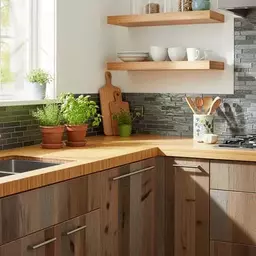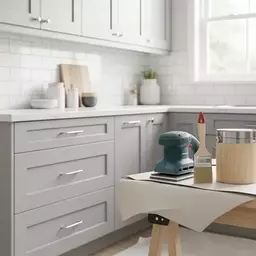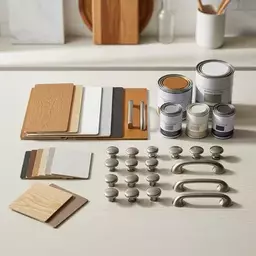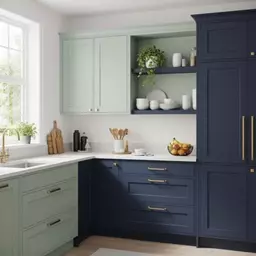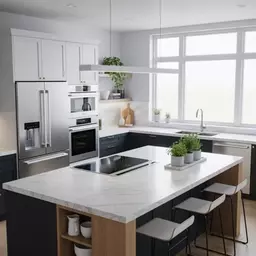Have you ever considered how your kitchen renovation choices impact the planet? A staggering amount of waste is generated from traditional renovations, but opting for sustainable kitchen refacing can transform your space while conserving our environment. Let’s explore the pivotal lessons from embracing eco-friendly choices in kitchen design.
What You Will Learn
- Waste Reduction: Sustainable kitchen refacing minimizes landfill waste by keeping existing structures intact and avoiding unnecessary replacements.
- Resource Conservation: By choosing to reface instead of replace, you conserve valuable resources and reduce energy consumption associated with new product manufacturing.
- Health Benefits: Opt for non-toxic finishes and low-VOC products to improve indoor air quality, creating a healthier kitchen environment for your family.
- Cost Efficiency: Sustainable materials often prove to be more durable and require lower maintenance, leading to long-term savings.
- Unique Design: Materials like reclaimed wood can add distinct character and style, elevating the aesthetic appeal of your kitchen.
- Community Support: Sourcing materials from local suppliers not only supports your economy but also reduces carbon emissions from transportation.
Environmental Impact of Traditional Kitchen Renovations
The key factors influencing the environmental impact of traditional kitchen renovations include waste generation, resource consumption, and energy use. The visual below highlights the significance of sustainable choices in kitchen refacing.
Waste Generation
The removal of existing cabinetry and appliances contributes to landfill overcrowding.
Resource Consumption
Manufacturing new cabinets requires valuable resources like wood, contributing to deforestation.
Energy Use
The production and transportation of new materials consume significant energy, adding to carbon emissions.
Benefits of Sustainable Refacing
- Reduces landfill waste and lowers carbon emissions.
- Improves indoor air quality with non-toxic finishes.
- Can save money in the long run due to durability.
Embracing Eco-Friendly Choices: The Need for Sustainable Kitchen Refacing
In today's world, where the impact of our choices is more evident than ever, the way we approach home renovations is changing. Traditional kitchen renovations often lead to significant waste and environmental strain. At Kitchen Refacing Guide, we believe in the power of sustainable kitchen refacing to not only enhance the beauty of your space but also to minimize your ecological footprint. Have you ever thought about how much waste a full kitchen renovation generates? Let’s dive into why making eco-friendly choices in kitchen design is so important. For more ideas on how to update your kitchen, check out revamping your kitchen design.
Traditional kitchen renovations typically involve tearing out old cabinets and countertops, sending them to landfills. This process generates a lot of debris, as many materials are not biodegradable. By embracing sustainable practices, we can significantly reduce the amount of waste created during renovations. By choosing to reface instead of replace, you not only save materials but also time and money! Isn’t it encouraging to think that a small decision can lead to a big environmental impact?
The Environmental Impact of Traditional Kitchen Renovations
When we discuss the environmental impact of traditional kitchen renovations, we must consider several key factors:
- Waste Generation: The removal of existing cabinetry and appliances contributes to landfill overcrowding.
- Resource Consumption: Manufacturing new cabinets requires valuable resources like wood, which can contribute to deforestation.
- Energy Use: The production and transportation of new materials consume significant energy, adding to carbon emissions.
As homeowners, we have the power to choose alternatives that lessen these impacts. By focusing on refacing, we can keep existing structures intact while refreshing their look. This not only conserves materials but also reduces energy consumption associated with new product manufacturing. Isn’t it refreshing to know that you can save the planet while beautifying your home?
Understanding Sustainable Materials and Their Benefits
Choosing sustainable materials for your kitchen refacing project is a crucial step toward an eco-friendly renovation. Here are some of the key benefits of opting for sustainable materials:
- Renewable Resources: Many sustainable materials, like bamboo, are rapidly renewable, meaning they can be replenished in a short time.
- Low Environmental Impact: Sustainable materials generally have a smaller carbon footprint compared to traditional options.
- Improved Health: Non-toxic finishes can enhance indoor air quality, making your kitchen a healthier space.
At Kitchen Refacing Guide, we are passionate about educating homeowners on these benefits. When you choose sustainable materials, you're not just making a choice for style; you're making a choice for the planet. Have you ever considered how the materials in your kitchen can affect your family's health? It’s a vital aspect that often gets overlooked, but we’re here to shine a light on it! Discover more about top kitchen cabinet resurfacing materials to make eco-conscious choices.
Quick Summary
As we explore sustainable kitchen refacing, here’s a brief recap of the key points discussed so far:
- Traditional kitchen renovations generate significant waste and contribute to environmental strain.
- Choosing to reface instead of replace can save materials, time, and money while reducing landfill contributions.
- Opting for sustainable materials like bamboo and reclaimed wood not only benefits the environment but also enhances indoor health and aesthetic appeal.
Summarizing the Importance of Sustainable Materials in Kitchen Refacing
When it comes to kitchen renovations, the importance of sustainable materials cannot be overstated. Adopting eco-friendly options is not just about enhancing your home’s aesthetic appeal; it’s about making choices that foster a healthier planet. As a passionate advocate for sustainable home improvement, I want to highlight the significant benefits that come from choosing sustainable materials in your refacing projects.
One key takeaway from exploring sustainable kitchen renovations is the positive impact they have on both the environment and your home’s value. By opting for materials like bamboo and reclaimed wood, you not only contribute to reducing waste but also create a warm and inviting space. These choices echo the values of Kitchen Refacing Guide, where we believe that style and sustainability can go hand in hand!
Key Takeaways from Sustainable Kitchen Renovations
- Environmental Benefits: Sustainable materials reduce landfill waste and lower carbon emissions.
- Healthier Homes: Using non-toxic finishes and low-VOC products improves indoor air quality.
- Cost-Effectiveness: Sustainable options can save you money in the long run due to their durability and lower maintenance needs.
- Unique Aesthetics: Materials like reclaimed wood offer distinctive character that can elevate your kitchen’s design.
When considering a refacing project, it's essential to remember these benefits and how they align with our mission at Kitchen Refacing Guide. By making informed choices, you can achieve a beautiful kitchen that resonates with your personal style and environmental values.
Encouraging a Shift Towards Eco-Conscious Home Improvement Choices
As we move forward in our home improvement journeys, it’s crucial to promote eco-conscious choices. Every small decision can contribute to a larger movement towards sustainability in home design. Have you noticed how much more homeowners are prioritizing eco-friendly materials? This trend reflects a growing awareness of our collective environmental responsibility.
At Kitchen Refacing Guide, I encourage you to share this knowledge with friends and family. Speak about the benefits of sustainable materials in kitchen refacing, and inspire others to consider their impact on the environment. Together, we can create a ripple effect of positive change! For insights into cost-effective renovation methods, explore affordable kitchen refacing in Australia.
Taking Action: Next Steps for Your Sustainable Kitchen Refacing Project
Now that you’re aware of the importance of sustainable materials in kitchen refacing, it’s time to take action! Whether you’re planning to tackle the project yourself or seek professional assistance, there are simple steps you can follow to get started.
Finding local suppliers for sustainable materials is a great first step. By sourcing materials from nearby vendors, you not only support your local economy but also reduce your carbon footprint. Get ready to explore your options!
Finding Local Suppliers for Sustainable Materials
- Research local home improvement stores that focus on eco-friendly products.
- Check out specialty suppliers that offer sustainable wood and finishes.
- Visit farmer's markets or craft fairs where local artisans showcase reclaimed materials.
- Engage with online communities to find recommendations for sustainable suppliers in your area.
By connecting with local suppliers, you can find the perfect materials for your kitchen refacing project while championing sustainability. It’s all about making informed choices that align with your values!
Consulting with Professionals: How to Get Started with Your Refacing Project
If you feel overwhelmed by the options or need guidance, don’t hesitate to consult with professionals. Engaging with experts can be a valuable step in ensuring your project aligns with your vision and sustainability goals. Here’s how you can approach this:
- Schedule consultations with kitchen design professionals who specialize in sustainable materials.
- Ask for portfolios that showcase previous eco-friendly refacing projects.
- Discuss your budget and preferences openly to find the best solutions.
Involving professionals can streamline the process and help you make choices that truly reflect your style while promoting sustainability. For those interested in a DIY approach, consider learning about cabinet resurfacing techniques explained.
Inviting Reader Engagement: Share Your Sustainable Kitchen Refacing Experiences
Finally, I invite you to share your own experiences with sustainable kitchen refacing! Have you completed a project using eco-friendly materials? What challenges or successes have you encountered along the way? Your stories can inspire others to embark on their sustainable journeys.
At Kitchen Refacing Guide, we value community and collective knowledge. Let’s engage in a dialogue about how we can continue to improve our kitchens and our planet. Together, we can create beautiful, functional spaces that reflect our commitment to sustainability!
Recap of Key Points
Here is a quick recap of the important points discussed in the article:
- Embrace Sustainable Kitchen Refacing: Opting for refacing over full renovations reduces waste and conserves resources.
- Environmental Impact: Traditional renovations contribute to landfill waste and resource consumption; sustainable choices help mitigate these effects.
- Benefits of Sustainable Materials: Using materials like bamboo and reclaimed wood can lead to lower environmental impact and improved indoor air quality.
- Cost-Effectiveness: Sustainable options often save money in the long run due to their durability and lower maintenance requirements.
- Engage Local Suppliers: Supporting local suppliers of sustainable materials helps reduce carbon footprints and boosts local economies.
- Consult with Professionals: Seek guidance from experts specializing in sustainable kitchen designs to align your vision with eco-friendly practices.
- Inspire Others: Share your experiences with sustainable kitchen refacing to encourage a broader shift towards eco-conscious home improvement.
Frequently Asked Questions about Sustainable Kitchen Refacing
- What is sustainable kitchen refacing?
- Sustainable kitchen refacing involves updating the look of your kitchen cabinets and surfaces using existing structures and eco-friendly materials, reducing waste and conserving resources compared to a full renovation.
- How does sustainable refacing reduce waste?
- By keeping existing cabinet boxes intact and only replacing doors, drawer fronts, and exterior finishes, sustainable refacing significantly minimizes the amount of demolition debris sent to landfills.
- What are the benefits of using sustainable materials?
- Sustainable materials often include renewable resources (like bamboo), have a lower carbon footprint, can improve indoor air quality with non-toxic finishes, and are often durable, leading to long-term cost savings.
- Can sustainable kitchen refacing save money?
- Yes, refacing is generally more cost-effective than a full kitchen replacement. Additionally, many sustainable materials are durable and require less maintenance, leading to long-term savings.
- Where can I find local suppliers for sustainable materials?
- You can research local home improvement stores, specialty suppliers focusing on eco-friendly products, or even local artisans at markets. Online communities can also provide recommendations for sustainable suppliers in your area.
- Is it necessary to consult with professionals for a sustainable refacing project?
- While it's possible to DIY some aspects, consulting with professionals specializing in sustainable kitchen designs can help ensure your project aligns with your vision, budget, and environmental goals, and often streamlines the process.


